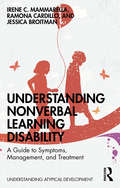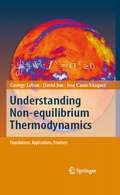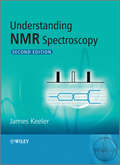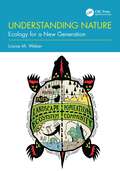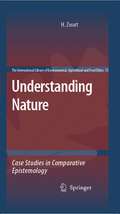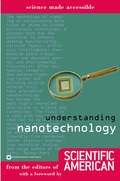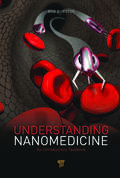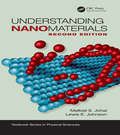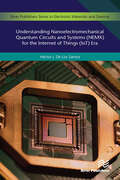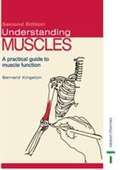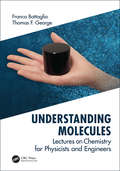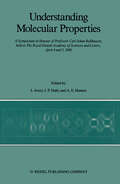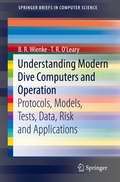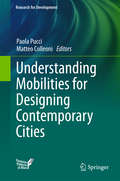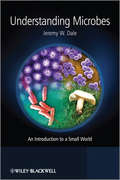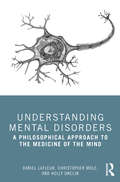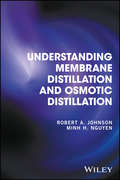- Table View
- List View
Understanding Nonverbal Learning Disability: A Guide to Symptoms, Management and Treatment (Understanding Atypical Development)
by Irene C. Mammarella Ramona Cardillo Jessica BroitmanThis essential book offers an accessible, evidence-based guide to Nonverbal Learning Disability (NVLD) informed by the most current research, and clinical and educational practice. It provides a thorough explanation of the science behind the condition, alongside ideas, support, and practical tips for managing the everyday challenges of the disorder at school and in family life. Mammarella, Cardillo, and Broitman describe the main characteristics of the condition from both theoretical and practical points of view, as well as examining the similarities and differences between NVLD and other neurodevelopmental disorders. They explore the cognitive and academic weaknesses and strengths of children with NVLD, and the emotional and social difficulties they may experience. The book also provides a systematic review of scientific studies in this field whilst focusing on issues of diagnostic criteria, as well as assessment and intervention strategies. Practical examples are given for teachers and parents to help support children with NVLD in improving their visuospatial and motor skills, as well as peer-social relations, and in promoting the child’s individual abilities. Understanding Nonverbal Learning Disability is essential reading for parents and practitioners in clinical and educational psychology, and health and social care, and students in these fields.
Understanding Nonverbal Learning Disability: A Guide to Symptoms, Management and Treatment (Understanding Atypical Development)
by Irene C. Mammarella Ramona Cardillo Jessica BroitmanThis essential book offers an accessible, evidence-based guide to Nonverbal Learning Disability (NVLD) informed by the most current research, and clinical and educational practice. It provides a thorough explanation of the science behind the condition, alongside ideas, support, and practical tips for managing the everyday challenges of the disorder at school and in family life. Mammarella, Cardillo, and Broitman describe the main characteristics of the condition from both theoretical and practical points of view, as well as examining the similarities and differences between NVLD and other neurodevelopmental disorders. They explore the cognitive and academic weaknesses and strengths of children with NVLD, and the emotional and social difficulties they may experience. The book also provides a systematic review of scientific studies in this field whilst focusing on issues of diagnostic criteria, as well as assessment and intervention strategies. Practical examples are given for teachers and parents to help support children with NVLD in improving their visuospatial and motor skills, as well as peer-social relations, and in promoting the child’s individual abilities. Understanding Nonverbal Learning Disability is essential reading for parents and practitioners in clinical and educational psychology, and health and social care, and students in these fields.
Understanding Non-equilibrium Thermodynamics: Foundations, Applications, Frontiers
by Georgy Lebon David JouDiscover the many facets of non-equilibrium thermodynamics. The first part of this book describes the current thermodynamic formalism recognized as the classical theory. The second part focuses on different approaches. Throughout the presentation, the emphasis is on problem-solving applications. To help build your understanding, some problems have been analyzed using several formalisms to underscore their differences and their similarities.
Understanding NMR Spectroscopy
by James KeelerThis text is aimed at people who have some familiarity with high-resolution NMR and who wish to deepen their understanding of how NMR experiments actually ‘work’. This revised and updated edition takes the same approach as the highly-acclaimed first edition. The text concentrates on the description of commonly-used experiments and explains in detail the theory behind how such experiments work. The quantum mechanical tools needed to analyse pulse sequences are introduced set by step, but the approach is relatively informal with the emphasis on obtaining a good understanding of how the experiments actually work. The use of two-colour printing and a new larger format improves the readability of the text. In addition, a number of new topics have been introduced: How product operators can be extended to describe experiments in AX2 and AX3 spin systems, thus making it possible to discuss the important APT, INEPT and DEPT experiments often used in carbon-13 NMR. Spin system analysis i.e. how shifts and couplings can be extracted from strongly-coupled (second-order) spectra. How the presence of chemically equivalent spins leads to spectral features which are somewhat unusual and possibly misleading, even at high magnetic fields. A discussion of chemical exchange effects has been introduced in order to help with the explanation of transverse relaxation. The double-quantum spectroscopy of a three-spin system is now considered in more detail. Reviews of the First Edition “For anyone wishing to know what really goes on in their NMR experiments, I would highly recommend this book” – Chemistry World “…I warmly recommend for budding NMR spectroscopists, or others who wish to deepen their understanding of elementary NMR theory or theoretical tools” – Magnetic Resonance in Chemistry
Understanding NMR Spectroscopy
by James KeelerThis text is aimed at people who have some familiarity with high-resolution NMR and who wish to deepen their understanding of how NMR experiments actually ‘work’. This revised and updated edition takes the same approach as the highly-acclaimed first edition. The text concentrates on the description of commonly-used experiments and explains in detail the theory behind how such experiments work. The quantum mechanical tools needed to analyse pulse sequences are introduced set by step, but the approach is relatively informal with the emphasis on obtaining a good understanding of how the experiments actually work. The use of two-colour printing and a new larger format improves the readability of the text. In addition, a number of new topics have been introduced: How product operators can be extended to describe experiments in AX2 and AX3 spin systems, thus making it possible to discuss the important APT, INEPT and DEPT experiments often used in carbon-13 NMR. Spin system analysis i.e. how shifts and couplings can be extracted from strongly-coupled (second-order) spectra. How the presence of chemically equivalent spins leads to spectral features which are somewhat unusual and possibly misleading, even at high magnetic fields. A discussion of chemical exchange effects has been introduced in order to help with the explanation of transverse relaxation. The double-quantum spectroscopy of a three-spin system is now considered in more detail. Reviews of the First Edition “For anyone wishing to know what really goes on in their NMR experiments, I would highly recommend this book” – Chemistry World “…I warmly recommend for budding NMR spectroscopists, or others who wish to deepen their understanding of elementary NMR theory or theoretical tools” – Magnetic Resonance in Chemistry
Understanding Nature: Ecology for a New Generation
by Louise M. WeberUnderstanding Nature is a new kind of ecology textbook: a straightforward resource that teaches natural history and ecological content, and a way to instruct students that will nurture both Earth and self. While meeting the textbook guidelines set forth by the Ecological Society of America, Understanding Nature has a unique ecotherapy theme, using a historical framework to teach ecological theory to undergraduates. This textbook presents all the core information without being unnecessarily wordy or lengthy, using simple, relatable language and discussing ecology in ways that any student can apply in real life. Uniquely, it is also a manual on how to improve one’s relationship with the Earth. This is accomplished through coverage of natural history, ecology, and applications, together with suggested field activities that start each chapter and thinking questions that end each chapter. The book includes traditional ecological knowledge as well as the history of scientific ecological knowledge. Understanding Nature teaches theory and applications that will heal the Earth. It also teaches long-term sustainability practices for one’s psyche. Professor Louise Weber is both an ecologist and a certified ecopsychologist, challenging ecology instructors to rethink what and how they teach about nature. Her book bridges the gap between students taking ecology to become ecologists and those taking ecology as a requirement, who will use the knowledge to become informed citizens.
Understanding Nature: Ecology for a New Generation
by Louise M. WeberUnderstanding Nature is a new kind of ecology textbook: a straightforward resource that teaches natural history and ecological content, and a way to instruct students that will nurture both Earth and self. While meeting the textbook guidelines set forth by the Ecological Society of America, Understanding Nature has a unique ecotherapy theme, using a historical framework to teach ecological theory to undergraduates. This textbook presents all the core information without being unnecessarily wordy or lengthy, using simple, relatable language and discussing ecology in ways that any student can apply in real life. Uniquely, it is also a manual on how to improve one’s relationship with the Earth. This is accomplished through coverage of natural history, ecology, and applications, together with suggested field activities that start each chapter and thinking questions that end each chapter. The book includes traditional ecological knowledge as well as the history of scientific ecological knowledge. Understanding Nature teaches theory and applications that will heal the Earth. It also teaches long-term sustainability practices for one’s psyche. Professor Louise Weber is both an ecologist and a certified ecopsychologist, challenging ecology instructors to rethink what and how they teach about nature. Her book bridges the gap between students taking ecology to become ecologists and those taking ecology as a requirement, who will use the knowledge to become informed citizens.
Understanding Nature: Case Studies in Comparative Epistemology (The International Library of Environmental, Agricultural and Food Ethics #13)
by Hub ZwartScience is not the only route to understanding nature. This volume presents a series of case studies in comparative epistemology, critically comparing the works of prominent representatives of the life sciences, such as Aristotle, Darwin, and Mendel, with the writings of literary masters, such as Andersen, Melville, Verne, and Ibsen. It constitutes a major contribution to the growing field of science and literature studies.
Understanding Nanotechnology
by Editors of Scientific AmericanTaken from the Greek, nano means 'one billionth part of' a whole; or very, very small. Nanotechnology is the next step after miniaturization. This book explores the cutting edge of a new technology that will find usage in almost every single aspect of modern society.
Understanding Nanomedicine: An Introductory Textbook
by Rob BurgessThis book comprehensively covers a broad range of therapeutic and diagnostic applications of nanotechnology, providing descriptions of cutting-edge discoveries along with historical perspectives. The text focuses on nanomaterials and nanoparticles, the sectors that hold the most promise for the future of medicine. The author look at how nanotechnol
Understanding Nanomaterials, Second Edition (Textbook Series in Physical Sciences)
by Malkiat S. Johal Lewis E. JohnsonPraise for the first edition"clear and informative” ?Chemistry World The authors provide the perfect training tool for the workforce in nanotech development by presenting the fundamental principles that govern the fabrication, characterization, and application of nanomaterials. This edition represents a complete overhaul, giving a much more complete, self-contained introduction. As before, the text avoids excessive mathematical detail and is written in an easy to follow, appealing style suitable for anyone, regardless of background in physics, chemistry, engineering, or biology. The organization has been revised to include fundamental physical chemistry and physics pertaining to relevant electrical, mechanical, and optical material properties. Incorporates new and expanded content on hard materials, semiconductors for nanoelectronics, and nonlinear optical materials. Adds many more worked examples and end-of-chapter problems. Provides more complete coverage of fundamentals including relevant aspects of thermodynamics, kinetics, quantum mechanics, and solid-state physics, and also significantly expands treatment of solid-phase systems. Malkiat S. Johal is a professor of physical chemistry at Pomona College, and earned his doctorate in physical chemistry at the University of Cambridge, UK. Lewis E. Johnson is a research scientist at the University of Washington, where he also earned his doctorate in chemistry and nanotechnology.
Understanding Nanomaterials, Second Edition (Textbook Series in Physical Sciences)
by Malkiat S. Johal Lewis E. JohnsonPraise for the first edition"clear and informative” ?Chemistry World The authors provide the perfect training tool for the workforce in nanotech development by presenting the fundamental principles that govern the fabrication, characterization, and application of nanomaterials. This edition represents a complete overhaul, giving a much more complete, self-contained introduction. As before, the text avoids excessive mathematical detail and is written in an easy to follow, appealing style suitable for anyone, regardless of background in physics, chemistry, engineering, or biology. The organization has been revised to include fundamental physical chemistry and physics pertaining to relevant electrical, mechanical, and optical material properties. Incorporates new and expanded content on hard materials, semiconductors for nanoelectronics, and nonlinear optical materials. Adds many more worked examples and end-of-chapter problems. Provides more complete coverage of fundamentals including relevant aspects of thermodynamics, kinetics, quantum mechanics, and solid-state physics, and also significantly expands treatment of solid-phase systems. Malkiat S. Johal is a professor of physical chemistry at Pomona College, and earned his doctorate in physical chemistry at the University of Cambridge, UK. Lewis E. Johnson is a research scientist at the University of Washington, where he also earned his doctorate in chemistry and nanotechnology.
Understanding Nanoelectromechanical Quantum Circuits and Systems (NEMX) for the Internet of Things (IoT) Era
by Héctor J. SantosThe operational theme permeating most definitions of the IoT concept, is the wireless communication of networked objects, in particular, smart sensing devices and machines, exchanging data a la Internet. In this book, a detailed look is taken at the fundamental principles of devices and techniques whose exploitation will facilitate the development of compact, power-efficient, autonomous, smart, networked sensing nodes underlying and encompassing the emerging IoT era.The book provides an understanding of nanoelectromechanical quantum circuits and systems (NEMX), as exemplified by firstly the uncovering of their origins, impetus and motivation, and secondly by developing an understanding of their device physics, including, the topics of actuation, mechanical vibration and sensing. Next the fundamentals of key devices, namely, MEMS/NEMS switches, varactors and resonators are covered, including a wide range of implementations. The book then looks at their energy supply via energy harvesting, as derived from wireless energy and mechanical vibrations. Finally, after an introduction to the fundamentals of IoT networks and nodes, the book concludes with an exploration of how the NEMX components are encroaching in a variety of emerging IoT applications.
Understanding Nanoelectromechanical Quantum Circuits and Systems (NEMX) for the Internet of Things (IoT) Era
by Héctor J. SantosThe operational theme permeating most definitions of the IoT concept, is the wireless communication of networked objects, in particular, smart sensing devices and machines, exchanging data a la Internet. In this book, a detailed look is taken at the fundamental principles of devices and techniques whose exploitation will facilitate the development of compact, power-efficient, autonomous, smart, networked sensing nodes underlying and encompassing the emerging IoT era.The book provides an understanding of nanoelectromechanical quantum circuits and systems (NEMX), as exemplified by firstly the uncovering of their origins, impetus and motivation, and secondly by developing an understanding of their device physics, including, the topics of actuation, mechanical vibration and sensing. Next the fundamentals of key devices, namely, MEMS/NEMS switches, varactors and resonators are covered, including a wide range of implementations. The book then looks at their energy supply via energy harvesting, as derived from wireless energy and mechanical vibrations. Finally, after an introduction to the fundamentals of IoT networks and nodes, the book concludes with an exploration of how the NEMX components are encroaching in a variety of emerging IoT applications.
Understanding Muscles: A Practical Guide to Muscle Function (PDF)
by Bernard KingstonPractical exercises and muscle tests feature throughout to demonstrate the function of each muscle, in addition to clear explanatory diagrams to illustrate each muscle and its attachments.
Understanding Molecules: Lectures on Chemistry for Physicists and Engineers
by Franco Battaglia Thomas F. GeorgeChemistry is a subject that many students with differing goals have to tackle. This unique general chemistry textbook is tailored to more mathematically-oriented engineering or physics students. The authors emphasize the principles underlying chemistry rather than chemistry itself and the almost encyclopedic completeness appearing in a common textbook of general chemistry is sacrificed for an emphasis to these principles. Contained within 300 pages, it is suitable for a one-semester course for students who have a strong background in calculus. Over 200 problems with answers are provided so that the students can check their progress.
Understanding Molecules: Lectures on Chemistry for Physicists and Engineers
by Franco Battaglia Thomas F. GeorgeChemistry is a subject that many students with differing goals have to tackle. This unique general chemistry textbook is tailored to more mathematically-oriented engineering or physics students. The authors emphasize the principles underlying chemistry rather than chemistry itself and the almost encyclopedic completeness appearing in a common textbook of general chemistry is sacrificed for an emphasis to these principles. Contained within 300 pages, it is suitable for a one-semester course for students who have a strong background in calculus. Over 200 problems with answers are provided so that the students can check their progress.
Understanding Molecular Properties: A Symposium in Honour of Professor Carl Johan Ballhausen, held at The Royal Danish Academy of Sciences and Letters, April 4 and 5, 1986
by John S. Avery Jens Peder Dahl Paul R. Hansen"The Theory of Atomic Spectra", surrrrnanzlllg all that was then known about the quantum theory of free atoms; and in 1961, J.S. Griffith published "The Theory of Transition Metal Ions", in which he combined the ideas in Condon and Shortley's book with those of Bethe, Schlapp, Penney and Van Vleck. All this work, however, was done by physicists, and the results were reported in a way which was more accessable to physicists than to chemists. In the meantime, Carl J. Ballhausen had been studying quantum theory with W. Moffitt at Harvard; and in 1962 (almost simultaneously with Griffith) he published his extremely important book, "Introduction to Ligand Field Theory". This influential book was written from the standpoint of a chemist, and it became the standard work from which chemists learned the quantum theory of transition metal complexes. While it treated in detail the group theoretical aspects of crystal field theory, Carl J. Ballhausen's book also emphasized the limitations of the theory. As he pointed out, it is often not sufficient to treat the central metal ion as free (apart from the influence of the charges on the surrounding ligands): - In many cases hybridization of metal and ligand orbitals is significant. Thus, in general. a molecular orbital treatment is needed to describe transition metal complexes. However, much of the group theory developed In connection with crystal field theory can also be used in the molecular orbital treatment.
Understanding Modern Dive Computers and Operation: Protocols, Models, Tests, Data, Risk and Applications (SpringerBriefs in Computer Science)
by B. R. Wienke T. R. O'LearyThis brief provides a complete yet concise description of modern dive computers and their operations to date in one source with coupled applications for added understanding. Basic diving principles are detailed with practical computer implementations. Interrelated topics to diving protocols and operational procedures are included. Tests, statistics and correlations of computer models with data are underscored. The exposition also links phase mechanics to dissolved gases in modern decompression theory with mathematical relationships and equations used in dive computer synthesis. Applications focus upon and mimic dive computer operations within model implementations for added understanding.This comprehensive resource includes a complete list of dive computers that are marketed and their staging models, as well as a complete list of diveware marketed and their staging algorithms, linkage of pertinent wet and dry tests to modern computer algorithms, a description of two basic computer models with all constants and parameters, mathematical ansatz of on-the-fly risk for surfacing at any dive depth, detailing of statistical techniques used to validate dive computers from data, and a description of profile Data Banks for computer dive model correlations.The book will find an audience amongst computer scientists, doctors, underwater researchers, engineers, physical and biosciences diving professionals, explorers, chamber technicians, physiologists and technical and recreational divers.
Understanding Mobilities for Designing Contemporary Cities (Research for Development)
by Paola Pucci Matteo ColleoniThis book explores mobilities as a key to understanding the practices that both frame and generate contemporary everyday life in the urban context. At the same time, it investigates the challenges arising from the interpretation of mobility as a socio-spatial phenomenon both in the social sciences and in urban studies. Leading sociologists, economists, urban planners and architects address the ways in which spatial mobilities contribute to producing diversified uses of the city and describe forms and rhythms of different life practices, including unexpected uses and conflicts. The individual sections of the book focus on the role of mobility in transforming contemporary cities; the consequences of interpreting mobility as a socio-spatial phenomenon for urban projects and policies; the conflicts and inequalities generated by the co-presence of different populations due to mobility and by the interests gathered around major mobility projects; and the use of new data and mapping of mobilities to enhance comprehension of cities. The theoretical discussion is complemented by references to practical experiences, helping readers gain a broader understanding of mobilities in relation to the capacity to analyze, plan and design contemporary cities.
Understanding Microbes: An Introduction to a Small World
by Jeremy W. DaleWe can’t see them, but microbes are the dominant form of life on Earth. They make up half of the world’s biomass. They were here billions of years before we were, and they will be here after we are gone. Without their activity, life as we know it would be impossible. Even within our own bodies, there are ten times as many bacterial cells as human cells. Understanding Microbes provides a clear, accessible introduction to this world of microbes. As well as looking at a selection of infectious diseases, including how they are prevented and treated, the book explores the importance of microbes in the environment, in the production and preservation of food, and their applications in biotechnology. This lively and engaging book provides the basics of microbiology, in a contemporary context. It will be equally useful for students across the biological, environmental and health sciences, and for the curious reader wanting to learn more about this fascinating subject. A highly-readable, concise introduction to the basics of microbiology placed in the context of the very latest developments in molecular biology and their impact on the microbial world. Numerous real-world examples range from how cows digest grass to the role of microbes in cancer and the impact of climate change Well-illustrated in full colour throughout. Written by an Author with a proven track record in teaching, writing and research.
Understanding Microbes: An Introduction to a Small World
by Jeremy W. DaleWe can’t see them, but microbes are the dominant form of life on Earth. They make up half of the world’s biomass. They were here billions of years before we were, and they will be here after we are gone. Without their activity, life as we know it would be impossible. Even within our own bodies, there are ten times as many bacterial cells as human cells. Understanding Microbes provides a clear, accessible introduction to this world of microbes. As well as looking at a selection of infectious diseases, including how they are prevented and treated, the book explores the importance of microbes in the environment, in the production and preservation of food, and their applications in biotechnology. This lively and engaging book provides the basics of microbiology, in a contemporary context. It will be equally useful for students across the biological, environmental and health sciences, and for the curious reader wanting to learn more about this fascinating subject. A highly-readable, concise introduction to the basics of microbiology placed in the context of the very latest developments in molecular biology and their impact on the microbial world. Numerous real-world examples range from how cows digest grass to the role of microbes in cancer and the impact of climate change Well-illustrated in full colour throughout. Written by an Author with a proven track record in teaching, writing and research.
Understanding Mental Disorders: A Philosophical Approach to the Medicine of the Mind
by Daniel Lafleur Christopher Mole Holly OnclinUnderstanding Mental Disorders aims to help current and future psychiatrists, and those who work with them, to think critically about the ethical, conceptual, and methodological questions that are raised by the theory and practice of psychiatry. It considers questions that concern the mind’s relationship to the brain, the origins of our norms for thinking and behavior, and the place of psychiatry in medicine, and in society more generally. With a focus on the current debates around psychiatry’s diagnostic categories, the authors ask where these categories come from, if psychiatry should be looking to find new categories that are based more immediately on observations of the brain, and whether psychiatrists need to employ any diagnostic categories at all. The book is a unique guide for readers who want to think carefully about the mind, mental disorders, and the practice of psychiatric medicine.
Understanding Mental Disorders: A Philosophical Approach to the Medicine of the Mind
by Daniel Lafleur Christopher Mole Holly OnclinUnderstanding Mental Disorders aims to help current and future psychiatrists, and those who work with them, to think critically about the ethical, conceptual, and methodological questions that are raised by the theory and practice of psychiatry. It considers questions that concern the mind’s relationship to the brain, the origins of our norms for thinking and behavior, and the place of psychiatry in medicine, and in society more generally. With a focus on the current debates around psychiatry’s diagnostic categories, the authors ask where these categories come from, if psychiatry should be looking to find new categories that are based more immediately on observations of the brain, and whether psychiatrists need to employ any diagnostic categories at all. The book is a unique guide for readers who want to think carefully about the mind, mental disorders, and the practice of psychiatric medicine.
Understanding Membrane Distillation and Osmotic Distillation
by Robert A. Johnson Minh H. NguyenThis book addresses principles and practical applications of membrane distillation and osmotic distillation, separation technologies which are gaining increasing attention due to their advantages over conventional concentration processes.• Addresses membrane and osmotic distillation, two closely related and novel processes that offer several advantages over conventional concentration processes• Has a widespread impact and application of the technology in industries such as food, environment, and nuclear clean-up / containment• Covers theoretical aspects of both processes, the properties of hydrophobic membranes, process economics, integrated processes and future prospects.• Caters the presentation caters for the diversity of readership with respect to links with membrane technologies.
